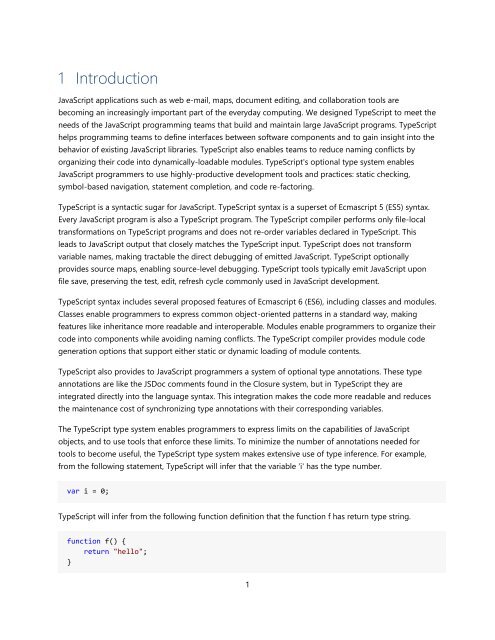TypeScript Language Specification v1.5
TypeScript Language Specification v1.5
TypeScript Language Specification v1.5
You also want an ePaper? Increase the reach of your titles
YUMPU automatically turns print PDFs into web optimized ePapers that Google loves.
1 Introduction<br />
JavaScript applications such as web e-mail, maps, document editing, and collaboration tools are<br />
becoming an increasingly important part of the everyday computing. We designed <strong>TypeScript</strong> to meet the<br />
needs of the JavaScript programming teams that build and maintain large JavaScript programs. <strong>TypeScript</strong><br />
helps programming teams to define interfaces between software components and to gain insight into the<br />
behavior of existing JavaScript libraries. <strong>TypeScript</strong> also enables teams to reduce naming conflicts by<br />
organizing their code into dynamically-loadable modules. <strong>TypeScript</strong>'s optional type system enables<br />
JavaScript programmers to use highly-productive development tools and practices: static checking,<br />
symbol-based navigation, statement completion, and code re-factoring.<br />
<strong>TypeScript</strong> is a syntactic sugar for JavaScript. <strong>TypeScript</strong> syntax is a superset of Ecmascript 5 (ES5) syntax.<br />
Every JavaScript program is also a <strong>TypeScript</strong> program. The <strong>TypeScript</strong> compiler performs only file-local<br />
transformations on <strong>TypeScript</strong> programs and does not re-order variables declared in <strong>TypeScript</strong>. This<br />
leads to JavaScript output that closely matches the <strong>TypeScript</strong> input. <strong>TypeScript</strong> does not transform<br />
variable names, making tractable the direct debugging of emitted JavaScript. <strong>TypeScript</strong> optionally<br />
provides source maps, enabling source-level debugging. <strong>TypeScript</strong> tools typically emit JavaScript upon<br />
file save, preserving the test, edit, refresh cycle commonly used in JavaScript development.<br />
<strong>TypeScript</strong> syntax includes several proposed features of Ecmascript 6 (ES6), including classes and modules.<br />
Classes enable programmers to express common object-oriented patterns in a standard way, making<br />
features like inheritance more readable and interoperable. Modules enable programmers to organize their<br />
code into components while avoiding naming conflicts. The <strong>TypeScript</strong> compiler provides module code<br />
generation options that support either static or dynamic loading of module contents.<br />
<strong>TypeScript</strong> also provides to JavaScript programmers a system of optional type annotations. These type<br />
annotations are like the JSDoc comments found in the Closure system, but in <strong>TypeScript</strong> they are<br />
integrated directly into the language syntax. This integration makes the code more readable and reduces<br />
the maintenance cost of synchronizing type annotations with their corresponding variables.<br />
The <strong>TypeScript</strong> type system enables programmers to express limits on the capabilities of JavaScript<br />
objects, and to use tools that enforce these limits. To minimize the number of annotations needed for<br />
tools to become useful, the <strong>TypeScript</strong> type system makes extensive use of type inference. For example,<br />
from the following statement, <strong>TypeScript</strong> will infer that the variable 'i' has the type number.<br />
var i = 0;<br />
<strong>TypeScript</strong> will infer from the following function definition that the function f has return type string.<br />
function f() {<br />
return "hello";<br />
}<br />
1


















